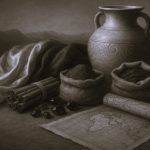
A mongol warrior on horseback, preparing a mounted archery shot / Stonnefrety7777, Wikimedia Commons
Because of its geography, Russia is a relatively easy country to invade from both east and west.

Curated/Reviewed by Matthew A. McIntosh
Public Historian
Brewminate
Introduction
“Give us trade,”demanded the Vikings from the north. “Try our religion,” urged missionaries from the south. Now a new voice was heard throughout Russia. “Pay us taxes,” ordered the Mongols of the east.
Because of its geography, Russia is a relatively easy country to invade from both east and west. It has suffered major invasions throughout its history. In the early 1200s, Russia endured one of the greatest and most important invasions in its history. The Mongols of central Asia invaded from the east.
The invasion route into Russia from the east is especially easy. A grassland known as the steppe (/step/) stretches some five thousand miles from central Asia to Eastern Europe.

Most of the steppe is low and level grassland. The steppe has cold winters and hot, dry summers, much like the Great Plains of North America. Tribes of hard-riding warriors from central Asia have used the steppe as an invasion route into Russia and Eastern Europe for thousands of years.
Russia does have one important mountain range, the Urals. But the Urals are not very high mountains. Over the centuries, erosion has worn them down to mostly hills.
Mapmakers often use the Urals as a dividing line between Europe and Asia. Many geographers consider Russia west of the Urals as part of Europe and Russia east of the Urals as part of Asia. To be sure, the Urals make a better boundary than barrier. The Urals have never been high enough to block the movement of traders and warriors. In the 1200s, the Urals did little to stop the fierce Mongol invaders who galloped in from the Asian steppe.
Ferocious Conquerors
During the 1200s, the Mongols were one of the most powerful peoples in the world. They originated in central Asia and spread out in all directions. They conquered China and most of western Asia, as well as Russia. They created an enormous empire.
The Mongols were bloodthirsty warriors. They swept across Russia on horses specially trained to withstand the snow and cold. The Mongols were vicious in war. They would thunder into an area and destroy anyone or anything in their way. They left behind them a trail of dead bodies, burned villages, and ruined farmlands. People were terrified of the Mongols. A warning of their coming sent people running for a hiding place, but there were few places to hide.
The Mongol attack on Russia was especially destructive and deadly. In 1238, the Mongols charged into Russia and burned fourteen cities in a single month. Two years later, they attacked and burned Kiev. The Mongols killed most of the people and destroyed houses and buildings. Kiev was the most important city in Russia at that time. It would never again be as powerful as it was before the Mongol invasion.
The Mongol armies did not remain long in Russia. After they left, a group of people called the Tatars ruled Russia. The Tatars were a blend of Mongol and Turkic tribes.Turkic tribes had fought with the Mongols and remained in western Russia after the Mongols withdrew.
The Beginnings of Moscow
Kiev had been losing power even before the Mongol invasions.Civil wars and raids by various nomadic tribes weakened the once powerful city, and fewer merchants came to trade there.As a result, the Russians in and around Kiev began to move to the northeast, where they built new farms, churches,and towns.
Moscow, one of these new settlements,rose from a small town into a key city.Located on strategic land and water trade routes, Moscow grew to become the most important center of a Russian state called Muscovy.
One ongoing problem prevented most of the Russian princes from growing even more powerful than they were. This was the problem of land ownership. When a Russian prince died, his sons split up his lands among themselves. Therefore, land holdings became smaller and smaller, and princes became weaker and weaker.

In the city-state of Muscovy, land was not equally divided among the sons when a prince died. The oldest son received the largest share of land. Thus, Muscovy remained large while other city-states got smaller.
Muscovy had some very strong rulers during the early part of the 1300s. Among them was Grand Prince Ivan I. He remained on good terms with the Tatars mostly because he was very good at making sure people paid taxes. He was known for his tight control over financial matters and made himself very wealthy. He was so good at his job that he was nicknamed “Ivan the Moneybag.”
From Czars and Shoguns: Early Russia and Feudal Japan, originally published by the Core Knowledge Foundation under the terms of a Creative Commons Attribution-NonCommercial-ShareAlike 4.0 International license.







